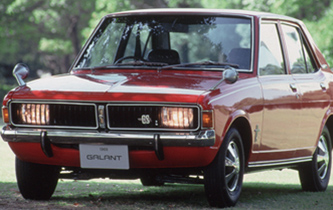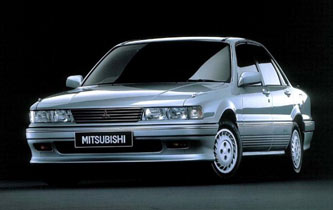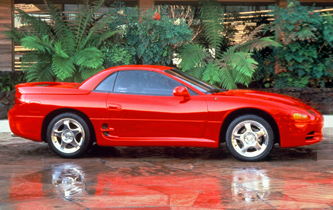
MITSUBISHI’S AUTOMOTIVE ORIGINS DATE BACK TO 1917, WHEN THE MITSUBISHI SHIPBUILDING CO., LTD. INTRODUCED THE MITSUBISHI MODEL A.
Mitsubishi’s automotive origins date back to 1917, when the Mitsubishi Shipbuilding Co., Ltd. introduced the Mitsubishi Model A, Japan’s first series-production automobile. An entirely hand-built seven-seater sedan based on the Fiat Tipo 3, it proved expensive compared to its American and European mass-produced rivals, and was discontinued in 1921 after only 22 had been built.
The Mitsubishi Model A was the first car ever to be adorned with the three-diamond emblem when launched in Japan marking the beginning of a global automotive company that has now spanned a century of technological innovation. With the Model A, Mitsubishi’s automotive history began with a 22-car production run of Japan’s very first series of mass-produced vehicles.
In 1934, Mitsubishi Shipbuilding was merged with the Mitsubishi Aircraft Co., a company established in 1920 to manufacture aircraft engines and other parts. The unified company was known as Mitsubishi Heavy Industries (MHI), MHI concentrated on manufacturing aircraft, ships, railroad cars and machinery, but in 1937 developed the PX33, a prototype sedan for military use.
Immediately following the end of the Second World War, the company returned to manufacturing vehicles, ordered by the Allied powers to be dismantled in 1950, the Mitsubishi Heavy Industries was split into three regional companies.










1980: Mitsubishi finally achieved annual production of one million cars in 1980


Chrysler and Mitsubishi agreed to unite in a vehicle manufacturing operation in Illinois. The venture provided a way to circumvent the voluntary import restrictions, while providing a new line of compact and subcompact cars for Chrysler. Diamond-Star Motors (DSM)—from the parent companies’ logos: three diamonds (Mitsubishi) and a pentastar (Chrysler)—was incorporated in October 1985, and in April 1986 ground was broken on a 1.9 million square-foot (177,000 m²) production facility. In 1987, the company was selling 67,000 cars a year in the U.S., but when the plant was completed in March 1988 it offered an annual capacity of 240,000 vehicles. Initially, three platform-sharing compact 2+2 coupés were released, the Mitsubishi Eclipse, Eagle Talon and Plymouth Laser, with other models being introduced in subsequent years.
The 1985 Hyundai Excel was sold in the United States as the Mitsubishi Precis between 1987 and 1994, whereas several other Mitsubishi models were rebadged as Hyundai, namely the Mitsubishi Chariot (as the Hyundai Santamo), the Mitsubishi Pajero (as the Hyundai Galloper) or the Mitsubishi Delica (as the Hyundai Porter).


1988: Mitsubishi Motors went public in 1988, ending its status as the only one of Japan’s eleven auto manufacturers to be privately held. Mitsubishi Heavy Industries agreed to reduce its share to 25 percent, retaining its position as largest single stockholder. Chrysler, meanwhile, increased its holding to over 20 percent.
1989: Motor Trend magazine names the Mitsubishi Galant VR-4 Import Car of the year.


1990: Mitsubishi Motors launches the Eclipse in America with the turbocharged 4G63 engine and all-wheel drive technology. Makes Car and Driver’s ’10 Best List’ from 1989 through 1992.
1991: Second-generation Montero features technological advances, Multimode ABS and Active Trac 4WD, which enable the driver to switch between rear-wheel drive and full-time four-wheel drive while driving at up to 60mph.
In 1991, Chrysler sold its equity stake in Diamond-Star Motors to its partner, and from then on they continued to share components and manufacturing on a contractual basis only. Chrysler decreased its interest in Mitsubishi Motors to less than three percent in 1992, and announced its decision to divest itself of all its remaining shares on the open market in 1993. The two companies then terminated their close alliance with Chrysler. With DMS, and Mitsubishi no longer supplying parts for engines and transmissions for Chrysler.
1992: Japan Car Research and Journalist Conference names Mitsubishi Motor’s Intelligent & Innovative Electronic Control System (INVECS) Adaptive Shift Control Technology of the Year. INVECS learns and adapts to drivers’ driving habits.
The company introduces next-generation engine with Mitsubishi Innovative Valve Timing and Lift Electronic Control (MIVEC), allowing maximum engine performance while maintaining fuel efficiency.
1992: Mitsubishi makes a major commitment to international motorsports completion by debuting the Lancer Evolution 1 in the World Rally Championship.

1996: Company leads the development of environmentally friendly engineering by launching the world’s first Gasoline Direct Injection (GDI) engine. Unlike ordinary engines, GDI enables fuel to be injected directly into the cylinder for lean-burn combustion.
1996: With a Dakar Rally-tested Active TracTM 4WD system, Montero Sport quickly establishes itself as a highly capable off-road midsize SUV in the U.S. and around the world.
1996: Tommi Makinen wins a record four consecutive WRC Driver’s Championships from 1996 to 1999, while Mitsubishi claims the WRC Manufacturer’s Championship in 1998.

1999: A world record: First electric car to cover 2,000 kilometers in 24 hours.

You must be logged in to post a comment.